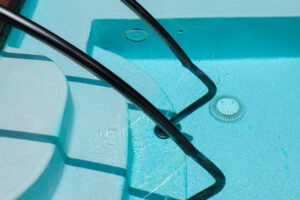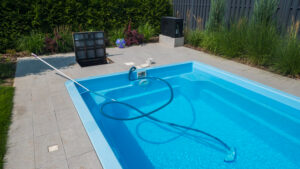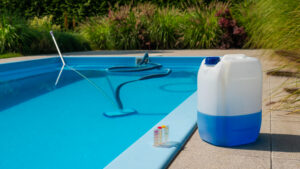Pool water might look simple, but it’s actually a mix of chemicals working together to keep your swim clean, safe, and comfortable. When that balance shifts, the water can turn cloudy, surfaces may stain, and equipment starts working too hard. Many pool owners feel overwhelmed by how to balance pool chemicals, but it doesn’t have to be complicated.
Balancing pool chemicals comes down to understanding three main elements: pH, chlorine, and alkalinity. These work together to create water that’s safe for swimmers and free from bacteria and algae. When we know which chemicals to use and when to use them, we can maintain crystal-clear water all season long.
In this article, you’ll learn why balanced water matters for your health and your pool’s equipment, understand the core chemical elements, and get a step-by-step guide to fix any imbalances. We’ll also cover how to maintain proper chemistry through different seasons so your pool stays perfect year-round.
Below, we’ll walk through each important aspect:
- Why balanced pool water matters more than you think
- Understanding the core chemical elements in your pool
- How to balance chemicals in a pool step by step
- How to fix a chemical imbalance in a pool
- Maintaining chemical balance through the seasons
Keep reading, we’ll walk you through everything you need to know about pool chemistry.
Why balanced pool water matters more than you think
Balanced pool water affects every aspect of your swimming experience, from the clarity you see to the safety of everyone who enters. When chemicals work together properly, they create an environment that protects both swimmers and pool equipment while maintaining crystal-clear water.
The role of chemistry in water clarity and safety
Water clarity depends on proper chemical balance working as a team. When pH levels stay between 7.2 and 7.8, chlorine works at its best to kill bacteria and algae.
If alkalinity falls outside the 80-120 ppm range, pH becomes unstable. This makes water cloudy and reduces chlorine effectiveness.
Pool safety requires balanced chemicals to prevent health risks. Unbalanced water can cause:
- Eye and skin irritation
- Bacterial growth
- Algae blooms
- Equipment damage
When we maintain proper chlorine levels between 1-3 ppm, the water stays sanitized. But chlorine only works well when other chemicals are balanced too.
Calcium hardness between 150-300 ppm prevents water from becoming too soft or too hard. Soft water can damage pool surfaces. Hard water creates scale buildup.
What happens when your pool water goes unbalanced
Unbalanced pool water creates a chain reaction of problems that get worse over time. High pH levels above 7.8 make chlorine weak and ineffective.
Immediate effects include:
- Cloudy or green water
- Strong chemical smells
- Skin and eye irritation
- Algae growth
Low pH below 7.2 makes water acidic and corrosive. This damages pool equipment, ladders, and surfaces. The water becomes uncomfortable for swimmers.
Long-term damage costs much more to fix. Acidic water eats away at concrete and metal parts. High pH creates calcium deposits that clog filters and pumps.
When alkalinity gets too low, pH swings up and down rapidly. This makes it almost impossible to maintain balanced pool water.
Bacteria and algae multiply quickly in unbalanced water. Once they take hold, it takes more chemicals and time to get the pool clean again.
How to balance pool water for long-term performance
We need to test pool water at least twice per week during swimming season. More frequent testing helps catch problems before they get serious.
Testing priorities include:
- pH levels
- Chlorine levels
- Total alkalinity
- Calcium hardness
Start by adjusting alkalinity first since it affects pH stability. Add alkalinity increaser if levels are below 80 ppm. Use muriatic acid if levels exceed 120 ppm.
Balance pH next by adding pH increaser or decreaser as needed. Wait 4-6 hours between adjustments to let chemicals distribute properly.
Pool safety requires maintaining proper chlorine levels daily. Add chlorine tablets or liquid chlorine to keep levels between 1-3 ppm.
Check calcium hardness monthly and adjust if needed. Use calcium chloride to raise hardness or partially drain the pool to lower it.
Keep detailed records of test results and chemical additions. This helps us spot patterns and prevent future imbalances.
Understanding the core chemical elements in your pool
Pool chemistry revolves around three main chemical groups that work together to keep your water clean and safe. Understanding how sanitizers, oxidizers, and balancers interact with pH, chlorine, and alkalinity forms the foundation of proper pool maintenance.
What are the 3 C’s of a pool?
The 3 C’s of pool chemistry are Chlorine, pH Control, and Calcium hardness. These three elements form the backbone of pool water balance.
Chlorine serves as our primary sanitizer. We need to maintain chlorine levels between 1.0 and 3.0 ppm for safe swimming conditions.
pH Control keeps water comfortable for swimmers. EPA-approved pool care guidelines recommend maintaining pH between 7.2 and 7.6 and total alkalinity between 60 and 120 ppm for optimal chlorine effectiveness and swimmer comfort.
Calcium hardness prevents equipment damage and surface problems. We maintain calcium levels between 150 and 300 ppm.
These three components must stay balanced. When one goes out of range, it affects the others and can cause cloudy water, skin irritation, or equipment damage.
How pH, chlorine, and alkalinity work together
pH, chlorine, and alkalinity work as a team to maintain water balance. Total alkalinity acts as a buffer that keeps pH stable between 80 and 120 ppm.
When alkalinity is too low, pH becomes unstable and bounces up and down. This makes chlorine less effective at killing bacteria and algae.
High alkalinity locks pH in place, making it hard to adjust. This creates similar problems with chlorine effectiveness.
Proper pH levels maximize chlorine’s sanitizing power. At 7.2 pH, chlorine works at about 80% efficiency. At 8.0 pH, efficiency drops to just 20%.
We balance these chemicals in order: alkalinity first, then pH, then chlorine. This sequence ensures each chemical can do its job properly.
The difference between sanitizers, oxidizers, and balancers
Pool chemicals fall into three main categories based on their function.
Sanitizers kill bacteria, viruses, and other harmful organisms. Chlorine is the most common sanitizer. Bromine and salt systems also work as sanitizers.
Oxidizers break down organic waste like sweat, oils, and dead skin cells. Shock treatments and chlorine serve as oxidizers. They clear cloudy water and eliminate chloramines.
Balancers adjust water chemistry levels. This includes pH increasers, pH decreasers, alkalinity increasers, and calcium hardness adjusters. Stabilizer (cyanuric acid) is also a balancer that protects chlorine from UV rays.
Each type serves a specific purpose. We use sanitizers daily, oxidizers weekly, and balancers as needed based on water tests.
How to balance chemicals in a pool step by step
Testing your pool water first is essential before adding any chemicals. The correct order matters because each chemical affects the others, and balancing pH before chlorine ensures better results.
In what order do you balance pool chemicals?
We need to follow a specific order when balancing pool chemicals. This prevents chemical conflicts and saves money.
Step 1: Test the water using a test kit or test strips. Take your water sample from elbow-deep water, away from return jets.
Step 2: Adjust total alkalinity first. Alkalinity acts as a buffer for pH. Keep it between 80-120 ppm.
Step 3: Balance pH levels next. Target 7.2-7.6 for best results. Use pH decreaser for high levels or pH increaser for low levels.
Step 4: Add sanitizer (chlorine). Maintain 1-3 ppm free chlorine. The balanced pH helps chlorine work better.
Step 5: Check calcium hardness if needed. Keep it between 150-300 ppm to protect pool surfaces.
Wait at least 4 hours between adding different chemicals. This prevents dangerous reactions and gives accurate readings.
Should you balance ph or chlorine first?
We always balance pH before adding chlorine. This order is crucial for effective sanitization.
High pH makes chlorine less effective. At pH 8.0, chlorine loses 80% of its sanitizing power. At pH 7.0, chlorine works at full strength.
Low pH causes problems too. It makes chlorine too aggressive and can damage pool equipment. Your skin and eyes will also feel irritated.
Why pH comes first:
- Chlorine works best at proper pH levels
- pH affects how long chlorine lasts
- Balanced pH prevents equipment damage
- Chemical testing becomes more accurate
Add pH adjuster first, then wait 2-4 hours before testing again. Once pH is correct, add your chlorine. This method uses less chemicals and works faster.
Testing tips for accurate chemical readings
Accurate chemical testing prevents costly mistakes and keeps swimmers safe. We recommend these practices for reliable results.
Use fresh test strips or reagents. Old test kits give wrong readings. Replace test strips every season and liquid reagents every two years.
Take water samples correctly. Collect water from elbow depth, away from return jets and skimmers. This gives you the most accurate reading of your pool’s chemistry.
Test at the right time. Check chemicals in the evening or early morning. Sunlight affects chlorine levels and can skew results.
Clean your test kit after each use. Rinse sample tubes with pool water before testing. Dirty equipment leads to false readings.
Follow timing guidelines. Wait at least 4 hours after adding chemicals before testing again. This gives chemicals time to circulate and mix properly.
Test your water 2-3 times per week during swimming season. Daily testing works best for heavily used pools or during hot weather.
Besides, according to the U.S. Department of Energy, using a pool cover can reduce chemical usage by 35–60% by keeping debris out, lowering evaporation, and maintaining stable water chemistry
How to fix a chemical imbalance in a pool
Chemical imbalances happen when pH, chlorine, or alkalinity levels move outside their proper ranges. We can fix most problems by identifying the root cause and applying the right chemicals in the correct amounts.
Common causes of imbalance and how to correct them
Heavy pool use is the most common cause of chemical imbalances. When many people swim, they add oils, sweat, and other contaminants that consume chlorine quickly.
Weather changes also affect water chemistry. Rain dilutes chemicals and adds debris. Hot weather makes chlorine evaporate faster.
Poor circulation creates dead spots where chemicals cannot work properly. We need to run the pump for 8-12 hours daily to keep water moving.
Here are the main fixes for common problems:
Low pH (below 7.2):
- Add soda ash or sodium carbonate
- Test after 4 hours and adjust if needed
- Run the pump to circulate chemicals
High pH (above 7.8):
- Add muriatic acid or sodium bisulfate
- Add small amounts at a time
- Wait 4 hours between additions
Low chlorine:
- Add liquid chlorine or chlorine tablets
- Shock the pool if levels are very low
- Check stabilizer levels
High chlorine:
- Stop adding chlorine products
- Run the pump continuously
- Add sodium thiosulfate for quick reduction
Using shock treatment and stabilizers properly
Shock treatment fixes severe chemical imbalances and kills bacteria that regular chlorine cannot handle. We use shock when water turns cloudy, smells bad, or has algae growth.
Choose the right shock type for your situation:
| Problem | Shock Type | Amount |
| Cloudy water | Calcium hypochlorite | 1 lb per 10,000 gallons |
| Algae growth | Sodium hypochlorite | 2 lbs per 10,000 gallons |
| Strong chlorine smell | Non-chlorine shock | Follow package directions |
Always shock at night when the sun cannot break down the chlorine. Add shock directly to the deep end while the pump runs.
Stabilizers protect chlorine from UV rays but too much causes problems. We need 30-50 parts per million of cyanuric acid.
High stabilizer levels make chlorine less effective. The only fix is to drain some water and add fresh water.
When to call a pool professional for help
Call a professional when basic treatments do not work after 48 hours. Some problems need special equipment or stronger chemicals that only licensed technicians can use.
Persistent algae growth that returns after shocking needs professional attention. We might have resistant algae strains or equipment problems.
Equipment damage from chemical imbalances requires expert help. Corroded heaters, damaged pool surfaces, or failing pumps need professional repair.
Water that stays cloudy after multiple treatments indicates deeper problems. Professionals can test for metals, phosphates, and other issues we cannot easily fix.
If you feel uncomfortable handling strong pool chemicals, professionals have the training and equipment to work safely. They can also create maintenance schedules to prevent future problems.
Maintaining chemical balance through the seasons
Pool chemical needs change significantly with temperature shifts and varying usage patterns. We need to adjust our approach based on weather conditions and implement consistent monitoring to prevent water quality problems.
How to balance ph in pool during temperature swings
Temperature changes affect pH levels more than most pool owners realize. Hot weather causes water to evaporate faster, concentrating chemicals and raising pH levels.
Cold weather slows down chemical reactions. This makes chlorine less effective at sanitizing water.
Summer pH Management:
- Test pH levels twice weekly during hot weather
- Add pH decreaser (muriatic acid) in small amounts
- Monitor after heavy sun exposure
Winter pH Adjustments:
- Check pH weekly even with reduced usage
- Use pH increaser more frequently in cold months
- Allow longer mixing time for chemical distribution
We should test pH before and after major temperature changes. A 20-degree temperature swing can shift pH by 0.2 to 0.4 points.
Rain also affects pH balance. Heavy rainfall typically lowers pH levels and dilutes chlorine concentration.
Adjustments for heavy usage or weather changes
Pool parties and storms create sudden chemical imbalances. We need to respond quickly to maintain safe water conditions.
After Heavy Pool Usage:
- Shock treat with chlorine within 24 hours
- Test and adjust pH levels immediately
- Run filtration system for 12-24 hours continuously
Weather-Related Adjustments:
- Add extra chlorine before expected storms
- Test alkalinity after heavy rainfall
- Clear debris promptly to prevent organic contamination
Hot, sunny days burn off chlorine faster. We should increase chlorine levels by 25% during heat waves.
Wind affects chemical distribution. Run pool pumps longer on windy days to ensure proper mixing.
Routine checks that prevent major issues
Regular testing prevents small problems from becoming expensive repairs. We recommend specific testing schedules based on pool usage and season.
Weekly Testing Schedule:
- pH levels: 7.2-7.6 range
- Chlorine: 1.0-3.0 ppm
- Alkalinity: 80-120 ppm
Monthly Deep Checks:
- Calcium hardness levels
- Cyanuric acid concentration
- Equipment inspection for wear
Document test results in a log. This helps us identify patterns and seasonal trends.
Clean skimmer baskets and pool filters regularly. Dirty filters reduce chemical effectiveness and create circulation problems.
We should inspect pool equipment monthly for leaks or damage. Faulty equipment can waste chemicals and create unsafe conditions.
Conclusion
Pool water chemistry becomes simple once we understand the basics. We need to focus on three main things: pH levels, chlorine, and alkalinity.
Testing our water regularly helps us catch problems early. We should check these levels at least twice a week during swimming season.
We don’t need to overcomplicate the process. Start with one chemical at a time and make small changes.
Clean water protects our equipment and keeps swimmers safe. When we balance chemicals We can prevent most pool problems by staying consistent with our routine. Test, adjust, and clean on a regular schedule.
The effort we put into balancing chemicals pays off quickly. We get clear water, working equipment, and a safe swimming area for everyone.
Remember that shocking the pool regularly prevents buildup of harmful compounds. This keeps our water fresh and odor-free.
With these basics, we can maintain healthy pool water all season long. Consistent care makes pool ownership easier and more enjoyable.
Schedule a water chemistry check or balancing service to keep your pool safe and sparkling all season.







